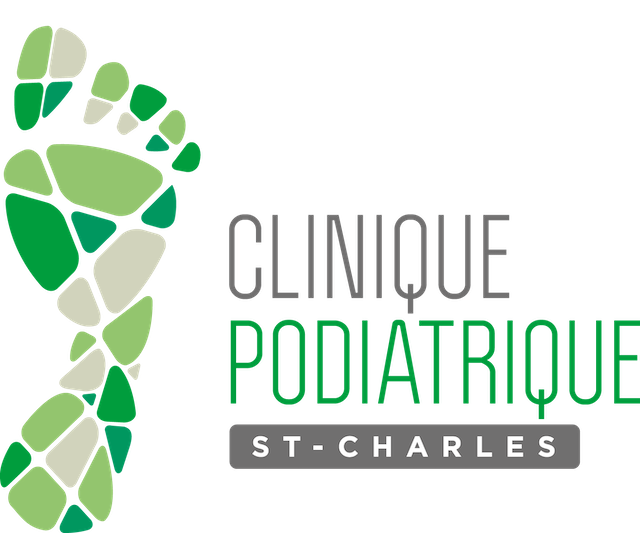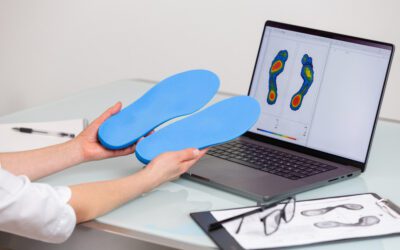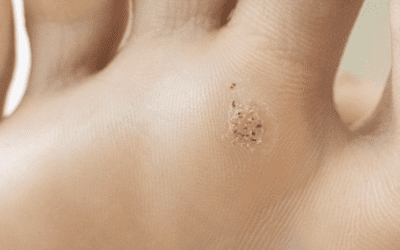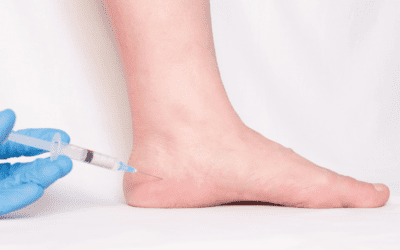Ingrown toenails, a common issue in podiatric clinics, frequently cause pain and discomfort.
Historically, treatments have evolved from rudimentary methods to refined medical approaches. Anatomically, an ingrown toenail occurs when the nail’s edge penetrates the toe’s skin, causing inflammation and pain. Foot morphology influences this, with certain types more prone to the condition. Modern podiatry has refined techniques, incorporating less invasive, targeted procedures for health. Treatment has shifted from complete nail removal to conservative methods like partial nail resection and nail bed correction.
Ingrown toenails Symptoms and Signs
Typically, an ingrown toenails causes sharp pain in the toe, often with redness and swelling. The surrounding skin becomes tender, and in some cases, an infection develops, indicated by pus discharge. Symptoms often worsen when wearing tight shoes or applying pressure to the affected toe. Monitoring these signs is essential for timely intervention and complication prevention.
Ingrown toenails can result from several factors. Wearing inappropriate, tight shoes or cutting nails improperly, like rounding them or cutting too short, also promotes their occurrence. Anatomical factors, such as excessive natural nail curvature, play a role. Additionally, genetic predisposition to ingrown toenails exists, particularly in those with a family history of this condition.
Infection Risks and Cellulitis
Untreated ingrown toenails pose a significant infection risk. Damaged skin around the nail becomes an entry point for bacteria, leading to local infection or more severe cellulitis – a deep skin infection. Infection symptoms include increased redness, swelling, warmth to the touch, and sometimes fever. Consulting a podiatrist is crucial if these signs appear to prevent progression to more severe complications.
Complications for Diabetic Patients
For diabetic patients, ingrown toenails are a major concern due to reduced blood circulation and decreased sensitivity in the feet. These factors increase the risk of serious infections and complications like ulcers. Moreover, slow healing, characteristic of diabetes, can escalate a minor issue into a potentially limb-threatening condition. Therefore, diabetic patients must pay special attention to preventing and promptly treating ingrown toenails.
Ingrown toenails Prevention
Preventing ingrown toenails involves wearing well-fitted shoes with ample toe space. Cutting nails straight across and avoiding rounding the edges is also crucial. Those with at-risk feet, like abnormal nail curvature, can benefit from regular podiatrist consultations for personalized advice and monitoring. Additionally, maintaining good foot hygiene and avoiding toe trauma also helps prevent ingrown toenails.
Home remedies, like salt foot baths or using cotton to lift the nail, offer temporary relief. However, these methods do not address the underlying cause and are often insufficient for advanced or infected cases. In contrast, professional podiatric care provides accurate assessment, tailored treatment, and the possibility of minor surgical interventions. While home remedies are accessible and convenient, specialized care allows for quicker, more effective resolution, reducing the risk of recurrence and infection.
Home Treatment
For mild cases, home treatments can be effective. Soaking the foot in warm saltwater several times a day can reduce inflammation and alleviate pain. Applying local antiseptics medically also helps prevent infection. However, if symptoms persist or worsen, consulting a podiatrist is imperative to avoid complications.
Shoes
Shoe choice plays a major role in preventing ingrown toenails. Ill-fitting, narrow, or pointy-toed shoes can exert excessive pressure on the toes, leading to nail ingrowth. It’s advised to choose shoes with sufficient toe space, good ventilation, and adequate arch support. High heels, which shift weight onto the toes, should be worn moderately. For those with sensitive feet or preexisting conditions, orthopedic or custom shoes may be a wise option.
Podiatrist Assessment and Treatment
During consultation, the podiatrist doctor assesses the nail’s condition and identifies the underlying cause of ingrowth. This evaluation may include a physical examination and, if necessary, tests to detect infection. Treatment varies based on ingrowth severity and infection presence.
In simple cases, the podiatrist may gently lift the nail and place a spacer to separate it from the skin. For more complex or recurrent cases, minor surgery may be required. This procedure, usually done under local anesthesia, involves removing the ingrown nail part and, in some cases, treating the nail bed to prevent recurrence. Postoperative follow-up is essential to ensure proper healing and prevent infections.
Special Cases
Athletes, due to their demanding activities, are particularly prone to ingrown toenails, especially in sports involving repeated foot impacts. Older adults, with naturally thicker nails and reduced mobility, are also at risk. Likewise, individuals whose jobs require long periods of walking or standing can develop this condition. For these groups, special attention to foot care and prompt podiatrist consultation at the first sign of an ingrown toenail is advised.
Ingrown toenails Treatment
Bevel Cut
The bevel cut, also known as partial resection, is a technique for treating ingrown toenails, particularly in their early or less severe stages. This method involves specifically cutting the nail to relieve pressure and prevent deeper ingrowth. Here’s a detailed overview of this technique:
Bevel Cut Procedure (Partial Resection)
- Identifying the Affected Area: The first step involves precisely identifying the nail part causing problems, usually the nail corner penetrating the skin.
- Cutting Technique: The bevel cut entails trimming the nail at an oblique angle, carefully removing the ingrown part. This cut reduces pressure on the inflamed area while leaving the rest of the nail intact.
- Immediate Care: After cutting, the podiatrist may apply a dressing or protector to separate the nail from the skin and allow interference-free healing.
Bevel Cut Advantages
- Non-Invasive: This method is less invasive than surgical interventions, making it a good option for less severe ingrown toenail cases.
- Quick Recovery: Recovery is usually fast, with a return to daily activities shortly after the procedure.
- Pain Relief: The bevel cut can provide immediate pain and pressure relief associated with the ingrown toenail.
Post-Procedure Considerations and Care
- Foot Hygiene: Good foot hygiene is essential after the procedure to avoid infection and promote quick healing.
- Follow-Up and Prevention: Following the podiatrist’s instructions for future nail cutting and preventing ingrown toenail recurrence is important.
- Symptom Monitoring: Any signs of infection or complications should be monitored and reported to a healthcare professional.
Partial Matricectomy
Partial matricectomy is a medical procedure commonly used to treat ingrown toenails, especially in recurrent or severe cases. This surgical intervention involves removing part of the nail matrix, the area at the nail’s base from where it grows. Here’s a detailed description of this procedure:
- Preparation and Anesthesia: The patient receives local anesthesia at the concerned toe to numb the area and minimize pain during the procedure.
- Removing the Ingrown Nail Portion: The podiatrist cuts and removes tissue and the nail part that has become ingrown.
- Treating the Nail Matrix: The most crucial part of the partial matricectomy is treating the nail matrix. The podiatrist applies a medication to the matrix area corresponding to the removed nail part. This application aims to destroy the matrix cells to prevent the nail from regrowing in that specific area, thus reducing recurrence risk.
- Healing and Postoperative Care: After the procedure, the toe is bandaged, and postoperative care is prescribed, which may include painkillers, wound care, and sometimes antibiotics to prevent infection.
Advantages and Considerations
- Efficacy: Partial matricectomy is highly effective in preventing ingrown toenail recurrence in the treated area.
- Minimally Invasive: Although surgical, the procedure is relatively minor and can often be performed in an office setting.
- Recovery: The recovery period is generally short, with a return to normal activities soon after.
In summary, partial matricectomy is an effective treatment option for ingrown toenails, especially in cases where other treatments have failed or when recurrence risk is high. As with any medical procedure, it’s important to discuss with your podiatrist the benefits, risks, and appropriate care before and after the operation.
In conclusion, managing ingrown toenails
Though seemingly simple, is crucial for foot care, this common condition in podiatric consultations can range from mild discomfort to severe complications, especially in at-risk patients like diabetics. Prevention plays a key role, involving wearing appropriate shoes, correct nail cutting, and rigorous foot hygiene.
Home treatments, while often effective for minor cases, should not replace professional consultation, especially in cases of persistent symptoms or infection. The podiatrist’s role is crucial, offering not only specialized care but also personalized advice tailored to each patient, whether an athlete, older adult, or individual with an active lifestyle.
Frequently Asked Questions about Ingrown Toenails
Common questions about ingrown toenails include:
“How do I know if I have an ingrown toenail?” An ingrown toenail is generally identifiable by pain, redness, and swelling around the nail.
“Can I treat an ingrown toenail at home?”Home treatments may be appropriate for mild cases, but if pain persists or signs of infection appear, it’s important to consult a podiatrist.
“When should I consult a podiatrist?” Moreover, people with special conditions, like diabetes, should seek professional care at the first signs of an ingrown toenail to prevent serious complications.



